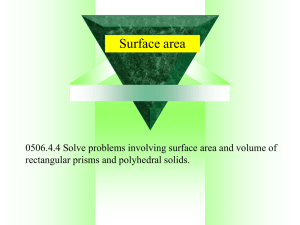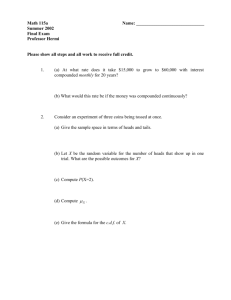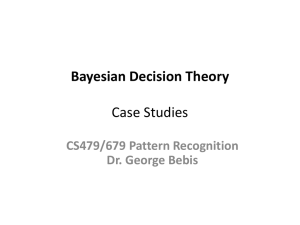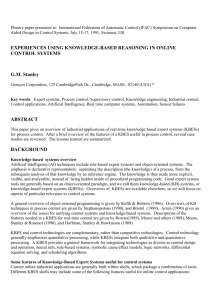- Krest Technology
advertisement
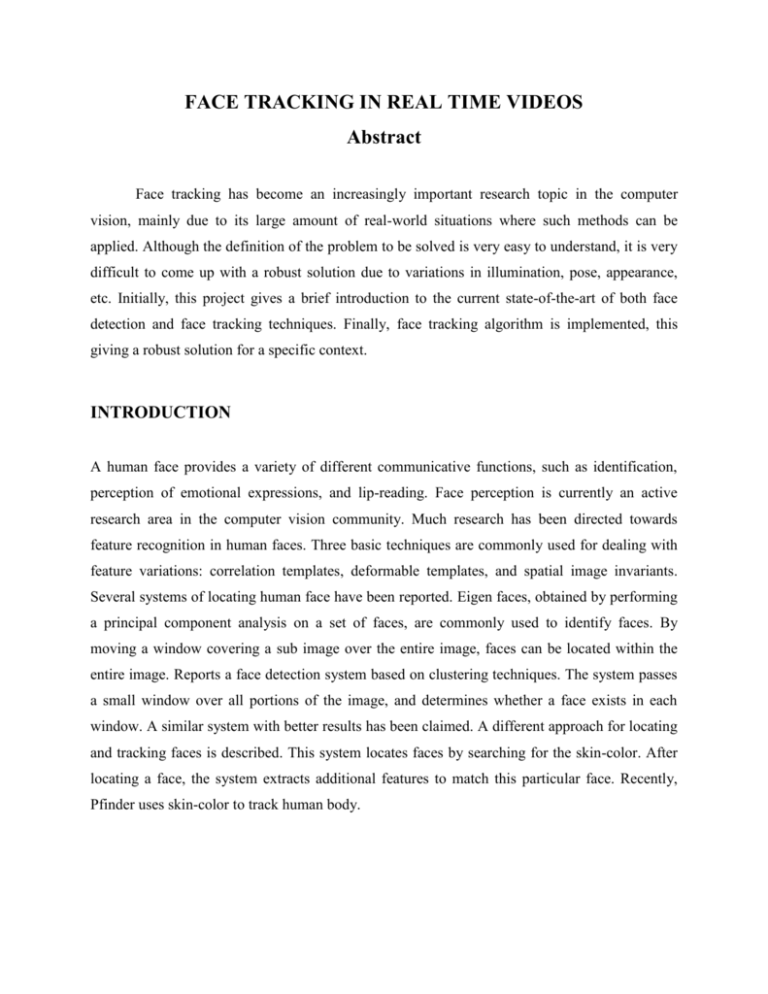
FACE TRACKING IN REAL TIME VIDEOS Abstract Face tracking has become an increasingly important research topic in the computer vision, mainly due to its large amount of real-world situations where such methods can be applied. Although the definition of the problem to be solved is very easy to understand, it is very difficult to come up with a robust solution due to variations in illumination, pose, appearance, etc. Initially, this project gives a brief introduction to the current state-of-the-art of both face detection and face tracking techniques. Finally, face tracking algorithm is implemented, this giving a robust solution for a specific context. INTRODUCTION A human face provides a variety of different communicative functions, such as identification, perception of emotional expressions, and lip-reading. Face perception is currently an active research area in the computer vision community. Much research has been directed towards feature recognition in human faces. Three basic techniques are commonly used for dealing with feature variations: correlation templates, deformable templates, and spatial image invariants. Several systems of locating human face have been reported. Eigen faces, obtained by performing a principal component analysis on a set of faces, are commonly used to identify faces. By moving a window covering a sub image over the entire image, faces can be located within the entire image. Reports a face detection system based on clustering techniques. The system passes a small window over all portions of the image, and determines whether a face exists in each window. A similar system with better results has been claimed. A different approach for locating and tracking faces is described. This system locates faces by searching for the skin-color. After locating a face, the system extracts additional features to match this particular face. Recently, Pfinder uses skin-color to track human body. OBJECTIVE The system has achieved a rate of 30+ frames/second using an HP-9000 workstation with a frame grabber and a Canon VC-C1 camera. It can track a person’s face while the person moves freely (e.g., walks, jumps, sits down and stands up) in a room. Three types of models have been employed in developing the system. First, we present a stochastic model to characterize skin-color distributions of human faces. The information provided by the model is sufficient for tracking a human face in various poses and views. PROBLEM DEFINITION The information provided by the model is sufficient for tracking a human face in various poses and views. This model is adaptable to different people and different lighting conditions in real-time. Second, a motion model is used to estimate image motion and to predict search window. Third, a camera model is used to predict and to compensate for camera motion. SOFTWARE AND HARDWARE REQUIREMENTS Operating system : Windows XP/7. Coding Language : MATLAB Tool MATLAB R 2012 : SYSTEM REQUIREMENTS: HARDWARE REQUIREMENTS: System : Pentium IV 2.4 GHz. Hard Disk : 40 GB. Floppy Drive : 1.44 Mb. Monitor : 15 VGA Colour. Mouse : Logitech. Ram : 512 Mb. CONCLUSION We have presented a real-time face tracker in this paper. The development of the real-time face tracker is significant in the following aspects. First, we have addressed the problems of what to track and how to track a human face in realtime through presenting the real-time face tracker. The methodology of developing the face tracker is useful for developing other real-time tracking systems. Second, we have demonstrated the feasibility of modeling techniques in developing a real-time tracking system. Finally, the real-time face tracker itself has many applications in human computer interaction and tele-conferencing. REFERENCES [1] R. Brunelli and T. Poggio. Face recognition: features versus templates. IEEE Trans. Pattern Analysis and Machine Intelligence, Vol. 15, No. 10, pp. 1042-1052, Oct. 1993. [2] A. Pentland, B. Moghaddam, and T. Starner. View-based and modular eigenspace for face recognition. Proc. IEEE Conf. on Computer Vision and Pattern Recognition, pp. 84-91, Seattle, WA, USA, 1994. [3] A. Yuille., P. Hallinan, and D. Cohen. Feature extraction from faces using deformable templates. Int. J. Computer Vision, Vol. 8, No. 2, pp. 99-111, 1992. [4] P. Sinha. Object recognition via image invariants: a case study. Investigative ophthalmology and visual science, Vol. 35, pp. 1735-1740, 1994. [5] M.A. Turk and A. Pentland. Face recognition using eigenfaces. Proc. IEEE Conf. on Computer Vision and Pattern Recognition, pp. 586-591, Maui, HI, USA, 1991. [6] K. Sung and T. Poggio, Example-based learning for viewbased human face detection. Technical Report 1521, MIT AI Lab, 1994. [7] H.A. Rowley, S. Baluja, and T. Kanade. Human face detection in visual scenes. Technical Report CMU-CS-95-158, CS department, CMU, 1995. [8] M. Hunke and A. Waibel. Face locating and tracking for human-computer interaction. Proc. Twenty-Eight Asilomar Conference on Signals, Systems & Computers, Monterey, CA, USA, 1994. [9] C. Wren, A. Azarbayejani, T. Darrell, and A. Pentland, “Pfinder: real-time tracking of the human body,” Proc. SPIE, Vol.2615, pp. 89-98, 1996. [10]J.K. Aggarwal and N. Nandhakumar. On the computation of motion from sequences of images-a review. Proceedings of the IEEE, Vol. 76, No. 8, pp. 917935, 1988.







